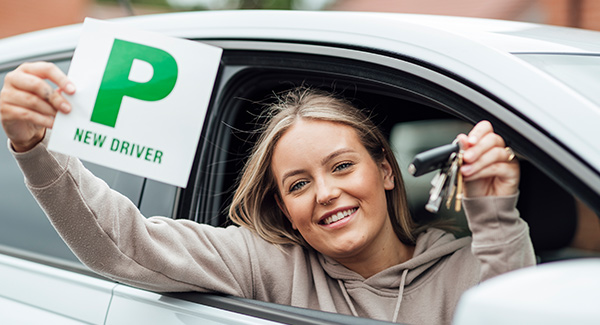P plates: What are they & should you use them?
- Editorial Team
Passing the driving test is a significant milestone for young motorists. But driving alone can be a daunting experience. After passing, new drivers no longer have the comfort of a driving instructor by their side or the option to display ‘L’ plates on their vehicles.
However, new drivers can display ‘P’ (probationary) plates on their vehicles instead to indicate to other road users that an inexperienced driver is at the wheel. A ‘P’ plate is a square sign with a green letter ‘P’ on a white background.

Is it a good idea to have ‘P’ plates?
While displaying ‘L’ plates is a legal requirement for learner drivers, ‘P’ Plates are optional. However, as young motorists are more at risk of accidents due to their age and inexperience, they should drive with ‘P’ plates until they become more competent and confident on the road.
Remember that displaying ‘P’ plates does not reflect on your driving skills. Instead, it might give you some leeway around other road users if you make a mistake.
Where should you display ‘P’ plates on a vehicle?
‘P’ plates should be placed at the front and back of the vehicle, ensuring they are clearly visible to other road users from a reasonable distance. Avoid fixing them to the windscreen or anywhere else that obstructs your view.
How long should you display ‘P’ plates?
There is no specific time limit for displaying ‘P’ plates. Some young drivers keep them on for the first year, while others may leave them on longer. You can drive with ‘P’ plates for as long as you need until you feel comfortable and confident enough to drive without them.
Can you drive with ‘P’ plates on the motorway?
Driving with ‘P’ plates is allowed on all types of roads, including motorways. ‘P’ plates can provide additional reassurance and peace of mind to young drivers who find motorway driving intimidating.
Is there a probationary period for new drivers?
New drivers are on probation for two years after passing their driving test. If they accumulate six or more penalty points within this period, their driving licence will be revoked. They must also apply for a new provisional licence and learn to drive again.
How else can new drivers stay safe?
New drivers face numerous challenges when driving alone. To help them stay safe on the roads, here are some additional measures to consider.
Consider a telematics policy
A telematics policy collects data on where, when, and how a vehicle is driven. The data is used to evaluate the policyholder’s overall driving performance, which affects their insurance premiums. The technology encourages better driving behaviour and improved road safety by rewarding safer drivers with lower premiums at renewal.
Pass Plus
Pass Plus is an optional driving course available to new drivers after passing their driving test. It provides new drivers with valuable driving skills and practical experience in conditions not typically covered during driving lessons, including motorways and night-time driving.
While there is no test, the driver’s performance is assessed throughout the course, and they are expected to meet the required standards for each module.
Achieving a Pass Plus qualification improves confidence and road safety. It can also result in reduced insurance premiums from certain insurance providers.
Practice driving with family and friends
New drivers can benefit from having a family member or experienced driver accompany them, offering guidance and encouragement to boost their confidence while driving.
Final thoughts
Using ‘P’ plates after passing your test is entirely your choice. Regardless of your decision, remember to drive safely and responsibly.
Share this article
Table of Contents
Learn more

First Time Driving Alone: Here’s What You Need To Know | A Choice
